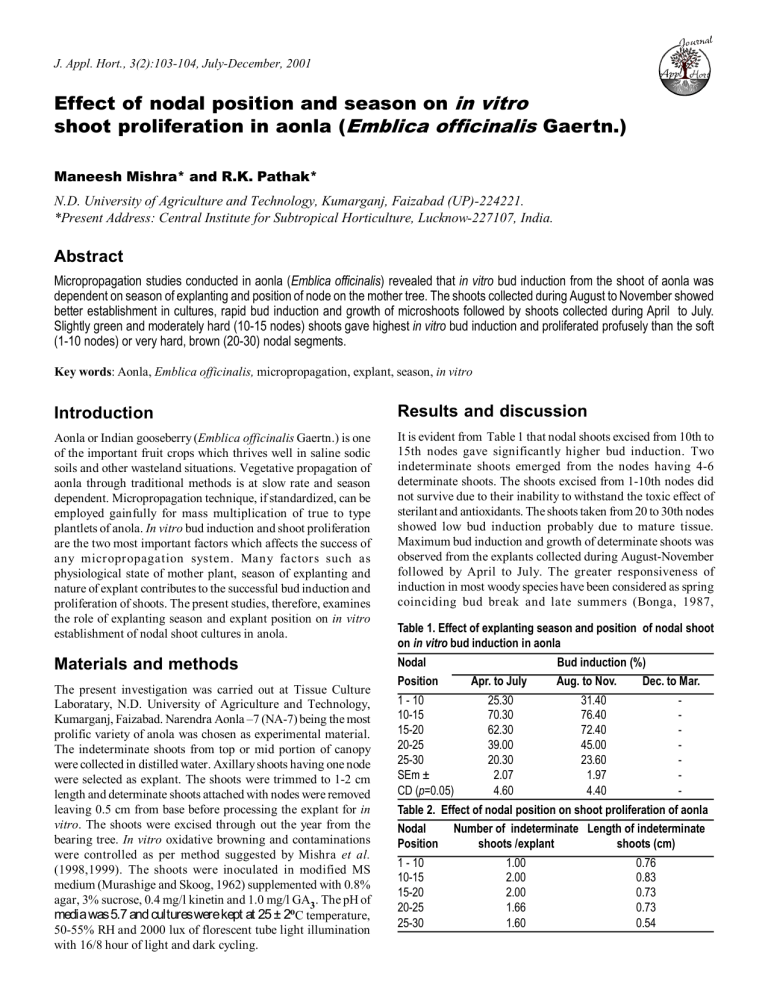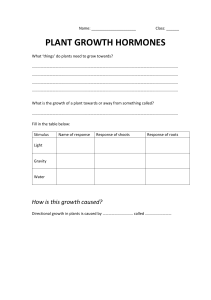
J. Appl. Hort., 3(2):103-104, July-December, 2001 Effect of nodal position and season on in vitro shoot proliferation in aonla (Emblica officinalis Gaertn.) Maneesh Mishra* and R.K. Pathak* N.D. University of Agriculture and Technology, Kumarganj, Faizabad (UP)-224221. *Present Address: Central Institute for Subtropical Horticulture, Lucknow-227107, India. Abstract Micropropagation studies conducted in aonla (Emblica officinalis) revealed that in vitro bud induction from the shoot of aonla was dependent on season of explanting and position of node on the mother tree. The shoots collected during August to November showed better establishment in cultures, rapid bud induction and growth of microshoots followed by shoots collected during April to July. Slightly green and moderately hard (10-15 nodes) shoots gave highest in vitro bud induction and proliferated profusely than the soft (1-10 nodes) or very hard, brown (20-30) nodal segments. Key words: Aonla, Emblica officinalis, micropropagation, explant, season, in vitro Introduction Results and discussion Aonla or Indian gooseberry (Emblica officinalis Gaertn.) is one of the important fruit crops which thrives well in saline sodic soils and other wasteland situations. Vegetative propagation of aonla through traditional methods is at slow rate and season dependent. Micropropagation technique, if standardized, can be employed gainfully for mass multiplication of true to type plantlets of anola. In vitro bud induction and shoot proliferation are the two most important factors which affects the success of any micropropagation system. Many factors such as physiological state of mother plant, season of explanting and nature of explant contributes to the successful bud induction and proliferation of shoots. The present studies, therefore, examines the role of explanting season and explant position on in vitro establishment of nodal shoot cultures in anola. It is evident from Table 1 that nodal shoots excised from 10th to 15th nodes gave significantly higher bud induction. Two indeterminate shoots emerged from the nodes having 4-6 determinate shoots. The shoots excised from 1-10th nodes did not survive due to their inability to withstand the toxic effect of sterilant and antioxidants. The shoots taken from 20 to 30th nodes showed low bud induction probably due to mature tissue. Maximum bud induction and growth of determinate shoots was observed from the explants collected during August-November followed by April to July. The greater responsiveness of induction in most woody species have been considered as spring coinciding bud break and late summers (Bonga, 1987, Materials and methods The present investigation was carried out at Tissue Culture Laboratary, N.D. University of Agriculture and Technology, Kumarganj, Faizabad. Narendra Aonla –7 (NA-7) being the most prolific variety of anola was chosen as experimental material. The indeterminate shoots from top or mid portion of canopy were collected in distilled water. Axillary shoots having one node were selected as explant. The shoots were trimmed to 1-2 cm length and determinate shoots attached with nodes were removed leaving 0.5 cm from base before processing the explant for in vitro. The shoots were excised through out the year from the bearing tree. In vitro oxidative browning and contaminations were controlled as per method suggested by Mishra et al. (1998,1999). The shoots were inoculated in modified MS medium (Murashige and Skoog, 1962) supplemented with 0.8% agar, 3% sucrose, 0.4 mg/l kinetin and 1.0 mg/l GA3. The pH of media was 5.7 and cultures were kept at 25 ± 2oC temperature, 50-55% RH and 2000 lux of florescent tube light illumination with 16/8 hour of light and dark cycling. Table 1. Effect of explanting season and position of nodal shoot on in vitro bud induction in aonla Nodal Bud induction (%) Position 1 - 10 10-15 15-20 20-25 25-30 SEm ± CD (p=0.05) Apr. to July 25.30 70.30 62.30 39.00 20.30 2.07 4.60 Aug. to Nov. 31.40 76.40 72.40 45.00 23.60 1.97 4.40 Dec. to Mar. - Table 2. Effect of nodal position on shoot proliferation of aonla Nodal Number of indeterminate Length of indeterminate Position shoots /explant shoots (cm) 1 - 10 1.00 0.76 10-15 2.00 0.83 15-20 2.00 0.73 20-25 1.66 0.73 25-30 1.60 0.54 104 Mishra and Pathak- In vitro shoot proliferation in aonla Fig. 1. Nodal shoot bud culture establishment and multiple shoot bud proliferation Wealander, 1983). The explants taken during December-March failed to induce bud break because aonla trees undergo dormancy during this period in northern India. Higher concentration of inhibitors in shoots could be the reason for complete failure of cultures. The physiological state of mother plant tissue at the time of explant excision has a definite influence on response of buds. Explants from actively growing shoots of the begining of the season generally gave best results. (Seabrook et al., 1976, Anderson, 1980). Bonga (1987) observed that lower or mid portion of branches are easier to establish in vitro than upper part of the branch. It is evident from Table 2 that the position of explant on the tree has dierect influence on the number and length of microshoots in vitro. The nodal shoots excised from 10-15th nodes produced more shoots (2.0 /culture) with increased length (0.83 cm). It can be concluded that for micropropagation of aonla, the explants excixed between 10-15 nodes of indeterminate shoot would be ideal explant. Maximum bud burst can be achieved on modified MS medium supplemented with 0.4 mg/l kinetin and 1.0 mg/l GA3. Acknowledgement The authors are grateful to Dr. R. K. Singh, Director of Research, N. D. University of Ag. & Tech., Kumarganj, Faizabad (U.P.) 224229. References Anderson, W.C. 1980. Mass propagation by tissue culture: Pinciples and practices, In: Proc. conference on nursery production of fruits through tissue culture application and feasibility. Agric. Res. Sel. Edn. Adm: USDA, Beltsville p 1-10. Bonga, J.M. 1987. Clonal propagation of mature trees, problem and possible solution in cell tissuse culture. In forestry. Martinus Nijhoff Pub; The Hague , Vol. 1, p 76-112. Murashige, T. and F. Skoog, 1962 . A revised medium for rapid growth and bioassay with tobacco tissue culture. Physiol. Plant., 15:473497 Mishra, M., R.P. Saxena, R.K. Pathak and A.K. Srivastava, 1998. Effect of antioxidants, phenol binding agents and explant waxing on in vitro browning of aonla. Prog. Hort., 30(3-4):128-134 Mishra, M., R.P. Saxena, R.K. Pathak and A.K. Srivastava, 1999. Studies on micropropagation of aonla Prog. Hort., 31(3-4):116122 Seabrook, J.E.A., B.G. Cumming and L.A. Diomme, 1976. The in vitro induction of adventitious shoot and root apices on narcissus cultivar tissue. Can. J. Bot., 54:814-819 Wealander, M. 1983. Biochemical and anatomical studies of birot (Betula pendula) buds exposed to different climatic condition in relation to growth in vitro. Basic life sciences. Plenum press. New York. Vol 44, p 29-99.


